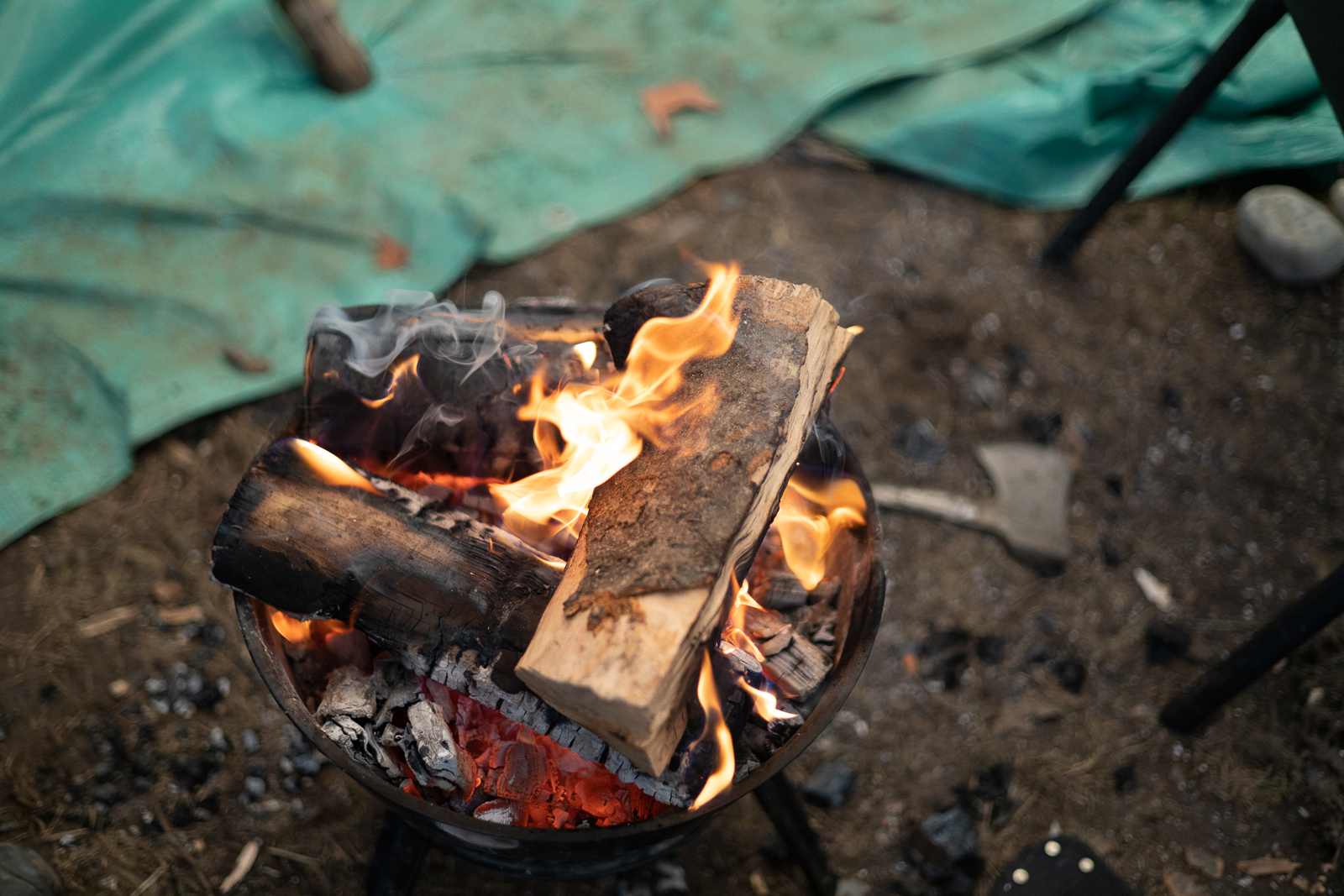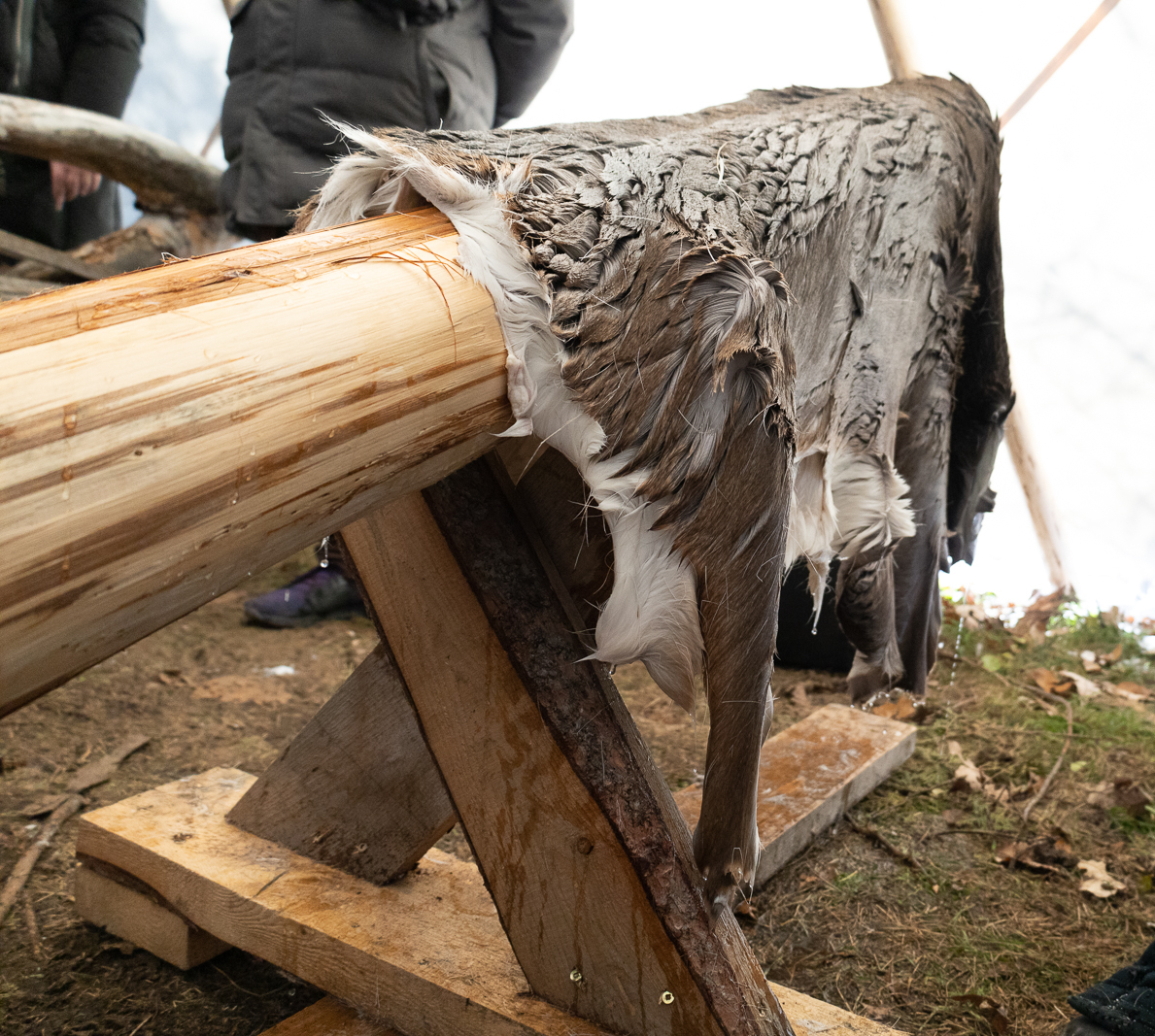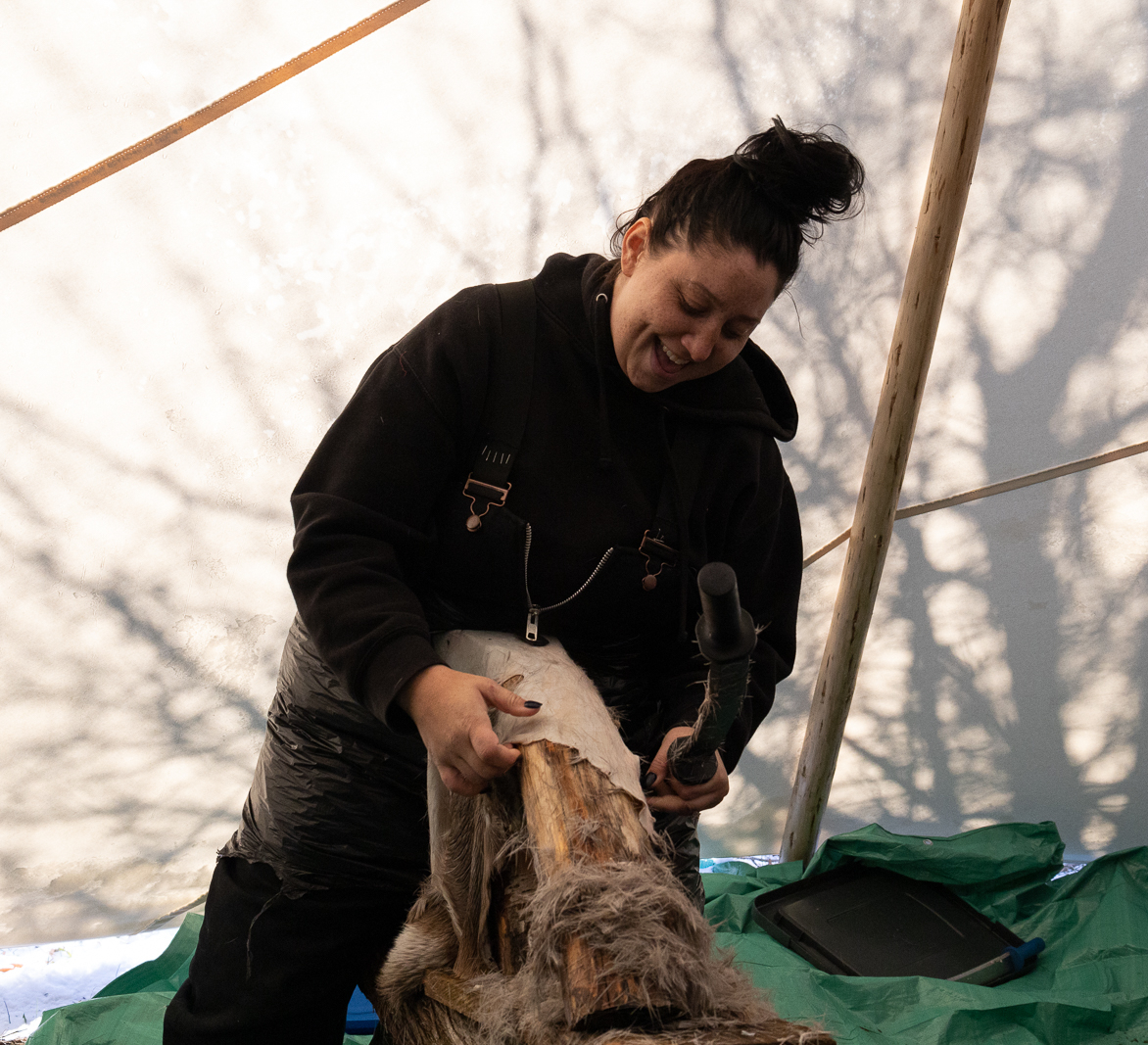Reclaiming what was stolen
Scroll down to continueParticipants gather in a teepee at Mādahòkì Farm off Hunt Club Road in Ottawa on Nov. 27 for the second day of a three-day hide tanning workshop. Photo by Natasha Bulowski
On a cold, crisp morning in Ottawa, roughly 30 people arrive at Mādahòkì Farm to learn how to work with deer and moose hides.
Since time immemorial, Indigenous people have used hides for clothing, shelter, ceremony and more, but Canada’s colonial policies like the Indian Act sought to stamp out these important traditions.
Gathered inside a teepee at Mādahòkì Farm in Ottawa, participants came together late last month to share cultural knowledge and create connections.
The three-day moose hide tanning workshop was hosted by the Assembly of Seven Generations (A7G), an Indigenous-owned and youth-led non-profit organization, and Aunties on the Road, an Indigenous doula collective operating through Minwaashin Lodge that offers no-cost, full-spectrum reproductive and sexual health services to Indigenous youth.

On the first day, participants brave the cold and snow outside, but on Day 2, the shelter of the teepee is essential thanks to freezing temperatures and persistent wind.

A deer hide sits on the elevated end of a log after soaking overnight to loosen the hair. The day before, participants scraped the fleshy side clean. Photo by Natasha Bulowski
Over the course of the weekend, several deer hides and one moose hide are soaked in water to soften them and loosen the hair. They're then fleshed and scraped, a process where the remaining flesh is removed from the underside of the hide and the hair is scraped off the top.
Fleshing and scraping is hard work, but after a night of rest, folks are eager to get started on Day 2.
Reconnection is resistance
Scroll down to continueA participant scrapes the hair off a deer hide. Photo by Natasha Bulowski
"It's overall well-being, and also resistance." — Gabrielle Fayant
“Through the experience of colonization and assimilation, and also capitalism, something that was stolen from almost all Indigenous Peoples was our connection to the land,” says Gabrielle Fayant, one of the co-founders of A7G.
“If you look at how these policies were enacted, and what they were intended to do, it was to remove us from the land so that settlers could have more access to resources, such as lumber, gas, coal, you name it ... it's a lot easier for someone to steal the land if the original inhabitants don't have that strong connection anymore.”
She says land- and cultural-based activities like this one are about helping Indigenous people restore that connection and “slowing down” in a world seemingly bent on consuming everything.
Having a connection to the land, plants, animals, water and people around you surrounds you with strong support systems and gives you purpose “because you're giving back to all of those things that you care about,” she says.

“It's like saying to all these systems of oppression and all these oppressors that no matter what, you couldn't take this away from us, and we're gonna come back even stronger and with more purpose and with so many more teachings of how to overcome these struggles.”

Working with hides is a collaborative job that requires many hands; folks are constantly helping each other adjust the position of the hides and switching out when arms inevitably become tired.

Chanelle Barnaby is here with her husband, Aronhientha Benedict, and says she is excited to learn how to tan her own hides so she can use them in her beadwork.
Being in foster care and group homes for part of her life made Barnaby feel disconnected from her culture. So, 10 years ago, she began seeking out cultural knowledge and says she has "been healing ever since."

A sense of belonging
Scroll down to continueGerald Zong (left) and Gabrielle Fayant (right) watch Lili Miller (centre) try fleshing a moose hide for the first time. Photo by Natasha Bulowski
For some participants, this is the first opportunity they have ever had to work with hides.

Lili Miller, 55, is from Neqotkuk (Tobique) First Nation and says this workshop is the first time she’s been able to participate in this important, long-standing cultural practice.
“You'd think that something that's been passed down generation to generation for thousands of years would still be alive now. But it's not because of colonialism and racism and assimilation,” says Miller. “A lot of people, like me, are disconnected from those teachings … Workshops like this help people like me to reconnect and reclaim what was, to be honest, stolen.
“It makes me feel connected to my ancestors ... And when I come to something like this, it's an opportunity for me to feel like I actually belong somewhere,” said Miller.
Working with hides and reconnecting with her culture also gives Miller a sense of responsibility to pass on this knowledge to her own children.
“This has survived. Somehow, it's passed through person to person to person to person, and it's ended up here, right here in front of me,” said Miller. “It's such a gift, and it feels like whatever path it took to get to me that the originators intended it to go on and on so that it would reach me.”

Gerald Zong, 26, said this weekend was the first time in 14 years he was able to prepare hides. Hailing from the O-Pipon-Na-Piwin Cree Nation of South Indian Lake, Man., Zong was raised by his grandparents and grew up on the traplines, where they taught him all about trapping, hunting, fishing and berry picking.
“Even though I was a child, the skills and knowledge stuck with me,” he said. “It rekindled my love of life … reminded me of what truly matters,” he said.
Sharing the knowledge
Scroll down to continueWaba Mako Ikwe watches as folks work on moose and deer hides. Photo by Natasha Bulowski
Waba Mako Ikwe (Shannon Chief) of the Algonquin Nation has a lifetime of experience working with hides.
“For babies that were teething, they're given a piece of hide, and we'd chew on it ... that's the first introduction we had,” she says, adding many Indigenous people are not so lucky to grow up and learn their culture from their community as a child.

On the second day of the workshop, the moose hide is removed from the Rubbermaid where it was soaking and draped across the log. It is far larger than the deer hide, and removing the outer layer of fur is very hard because they are such strong animals, says Waba Mako Ikwe.
Participants don black garbage bags to keep the scent of the moose hide and fur from seeping into their clothes.

The hides were donated to Aunties on the Road by Willie Groulx and Joseph Wabie of Timiskaming First Nation.
Moose hides are traditionally soaked in water containing a moose brain, because it has just the right amount of fat to help to keep the hide soft and supple.

In addition to sharing her knowledge with A7G and other groups, Waba Mako Ikwe is also an organizer of the Anishnabe Odinewin Camps, land-based language and culture camps for Anishnabe people to come together and restore the Anishnabe language, culture, teachings and ceremony. Careful thought and input from the community shaped the land- and language-based curriculum, and one day, the hope is to built a school out on the territory.
Language, culture and sharing are the main priorities of the camps, says Waba Mako Ikwe.
"Being able to have something put together where that knowledge is going to be transferred to the next generation to generation... so that we don't lose who we are, especially after when our elders experienced Indian residential schools... a lot of them could not come back and speak the language and all that kind of stuff. A lot of them are displaced," she says.
"So, it's a lot about holding on to our identity and our way of life."
'It's in your DNA'
Scroll down to continueOn Nov. 27, Day 2 of a three-day hide tanning workshop, participants pose with the hides they successfully scraped and fleshed. Photo by Natasha Bulowski
"It's in your DNA ... It's those things I should have been taught as a kid." — Gabrielle Fayant
“For anyone that's connecting, reconnecting to Indigenous cultures and your ancestors' cultures, you have to be a kid again,” says Fayant. “And that means literally not knowing anything, even if you're in your 40s and 50s.”

In the spring, Fayant says folks will have an opportunity to learn how to stretch, soften and smoke the hides.
A7G runs many programs and events to give folks the opportunity to connect with their culture and build connections within the community, including weekly youth gatherings, language classes, a trade-and-barter marketplace and other seasonal, land-based learning activities like gardening, kayaking and harvesting.
“The vision (of A7G) was always about restoring cultural teachings and creating safety for Indigenous youth and opportunities,” says Fayant.
But not only youth benefit from A7G's work.
In the summer, Miller, 55, says she went to a multi-weekend birch bark canoe-making workshop.
“That was amazing to have that opportunity ... living in the city you just don't have the opportunity to learn some cultural traditions,” she says. “The fact that A7G puts these on for free, and they offer rides for people, that is really breaking down barriers that allow Indigenous people to come and participate and learn.
“Because so many people don't know some of the traditions and teachings they may feel intimidated, but I've just found it's been nothing but welcoming.”
